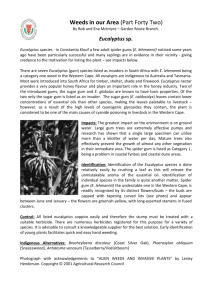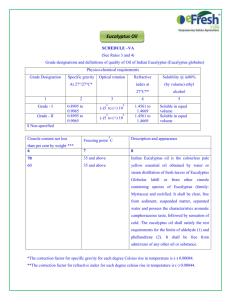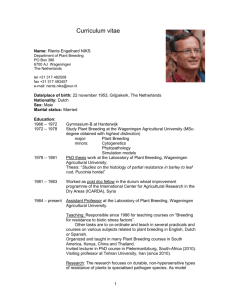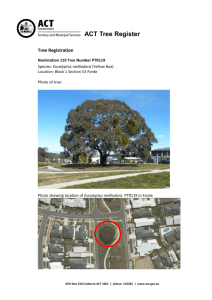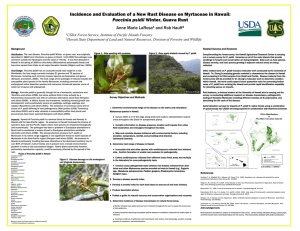Eucalyptus Pathosystems Introduction
advertisement
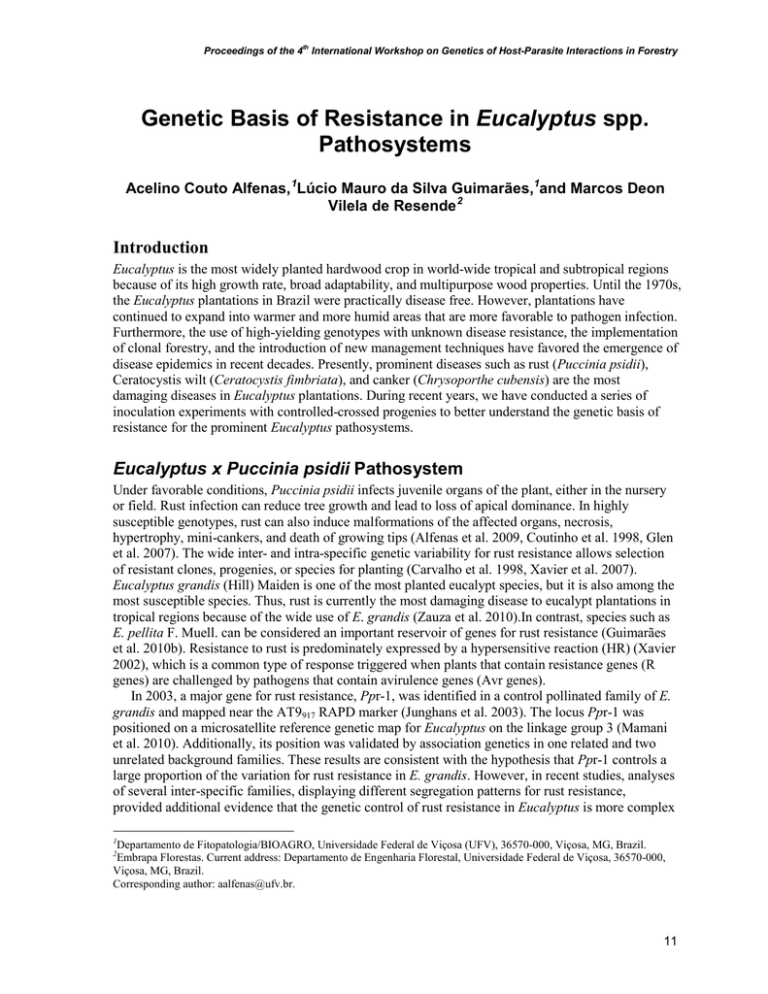
Proceedings of the 4th International Workshop on Genetics of Host-Parasite Interactions in Forestry Genetic Basis of Resistance in Eucalyptus spp. Pathosystems Acelino Couto Alfenas, 1Lúcio Mauro da Silva Guimarães,1and Marcos Deon Vilela de Resende 2 Introduction Eucalyptus is the most widely planted hardwood crop in world-wide tropical and subtropical regions because of its high growth rate, broad adaptability, and multipurpose wood properties. Until the 1970s, the Eucalyptus plantations in Brazil were practically disease free. However, plantations have continued to expand into warmer and more humid areas that are more favorable to pathogen infection. Furthermore, the use of high-yielding genotypes with unknown disease resistance, the implementation of clonal forestry, and the introduction of new management techniques have favored the emergence of disease epidemics in recent decades. Presently, prominent diseases such as rust (Puccinia psidii), Ceratocystis wilt (Ceratocystis fimbriata), and canker (Chrysoporthe cubensis) are the most damaging diseases in Eucalyptus plantations. During recent years, we have conducted a series of inoculation experiments with controlled-crossed progenies to better understand the genetic basis of resistance for the prominent Eucalyptus pathosystems. Eucalyptus x Puccinia psidii Pathosystem Under favorable conditions, Puccinia psidii infects juvenile organs of the plant, either in the nursery or field. Rust infection can reduce tree growth and lead to loss of apical dominance. In highly susceptible genotypes, rust can also induce malformations of the affected organs, necrosis, hypertrophy, mini-cankers, and death of growing tips (Alfenas et al. 2009, Coutinho et al. 1998, Glen et al. 2007). The wide inter- and intra-specific genetic variability for rust resistance allows selection of resistant clones, progenies, or species for planting (Carvalho et al. 1998, Xavier et al. 2007). Eucalyptus grandis (Hill) Maiden is one of the most planted eucalypt species, but it is also among the most susceptible species. Thus, rust is currently the most damaging disease to eucalypt plantations in tropical regions because of the wide use of E. grandis (Zauza et al. 2010).In contrast, species such as E. pellita F. Muell. can be considered an important reservoir of genes for rust resistance (Guimarães et al. 2010b). Resistance to rust is predominately expressed by a hypersensitive reaction (HR) (Xavier 2002), which is a common type of response triggered when plants that contain resistance genes (R genes) are challenged by pathogens that contain avirulence genes (Avr genes). In 2003, a major gene for rust resistance, Ppr-1, was identified in a control pollinated family of E. grandis and mapped near the AT9917 RAPD marker (Junghans et al. 2003). The locus Ppr-1 was positioned on a microsatellite reference genetic map for Eucalyptus on the linkage group 3 (Mamani et al. 2010). Additionally, its position was validated by association genetics in one related and two unrelated background families. These results are consistent with the hypothesis that Ppr-1 controls a large proportion of the variation for rust resistance in E. grandis. However, in recent studies, analyses of several inter-specific families, displaying different segregation patterns for rust resistance, provided additional evidence that the genetic control of rust resistance in Eucalyptus is more complex 1 Departamento de Fitopatologia/BIOAGRO, Universidade Federal de Viçosa (UFV), 36570-000, Viçosa, MG, Brazil. Embrapa Florestas. Current address: Departamento de Engenharia Florestal, Universidade Federal de Viçosa, 36570-000, Viçosa, MG, Brazil. Corresponding author: aalfenas@ufv.br. 2 11 GENERAL TECHNICAL REPORT PSW-GTR-240 and includes quantitative resistance traits (Alves et al. 2012).The recognition that both additive and non-additive genetic variation (epistasis) are important contributors to rust resistance in eucalypts reveals the complexity of this host-pathogen interaction and helps explain the success that breeding has achieved in selecting rust-resistant clones, where the additive and non-additive effects are readily captured. Eucalyptus x Ceratocystis fimbriata Pathosystem Due to its lethal nature, broad host range, and wide geographical distribution, Ceratocystis wilt caused by Ceratocystis fimbriata is currently one of the most important diseases of eucalyptus plantations in Brazil (Alfenas et al. 2009).Genetic variability for resistance to Ceratocystis wilt in Eucalyptus genotypes was confirmed by Zauza et al. (2004). Subsequently, Rosado et al. (2010) studied Ceratocystis wilt resistance by stem inoculations of E. grandis and E. urophylla S. T. Blake genotypes, and estimated the heritability and gains of selection in families derived from controlled interspecific crosses. In both species, some genotypes were highly resistant and others highly susceptible to Ceratocystis wilt. Estimates of individual narrow (50 percent) and broad (59 percent) sense heritability suggested a high degree of genetic control and low allelic dominance of the trait. A genetic gain inlesion size up to -74.4 percent was obtained from selection ofthe 50 best clones in the evaluated families. Continuing the studies with this pathosystem, Rosado (2009) built a microsatellite genetic map for the inter-specific, full-sibling family DGxUGL [(E. grandis x E. dunnii Maiden) x (E. urophylla x E. globulus)] (127 individuals) and detected five QTLs for Ceratocystis wilt resistance. Marker analysis showed that five markers located in the linkage groups 1, 3, 5, 8, and 10 were associated with significant quantitative effects on resistance with heritabilities ranging from 9.6 to 34.2. Eucalyptus x Chrysoporthe cubensis Pathosystem The existence of inter- and intra-specific genetic variability for canker resistance in eucalypts (Alfenas et al. 1983, Ferreira et al. 1978), together with the development of large-scale cloning in the 1980s, has led to the control of the disease through the selection and cloning of resistant genotypes (Alfenas et al. 2009). Recently, Guimarães et al. (2010a) evaluated resistance in E. grandis and E. urophylla trees, as well as in individuals from progenies derived from controlled crosses between the trees. Six-month-old plants were inoculated, and xylem and bark lesions were measured at 8 months post-inoculation. The results demonstrated that xylem lesions are strong indicators for the selection of resistant clones. The phenotypic analyses indicated the existence of high genetic variability for resistance in both species. Individual narrow and broad sense heritability estimates were 17 percent and 81 percent, respectively, suggesting that canker resistance is quantitative and highly dependent on dominance and epistasis. Due to the wide genetic variation for canker resistance in E. grandis and E. urophylla, the introduction of resistant parent trees into ongoing breeding programs may increase the chances of obtaining disease-resistant clones at the end of the selection program. The results of our study also reinforce the need for using artificial inoculation with C. cubensis, when selecting pathogen-resistant parent trees and progenies of Eucalyptus spp. Furthermore, these studies also demonstrate the importance of cloning resistant genotypes for disease control. Breeding for Disease Resistance Plantations of clones or elite-resistant varieties represent the most efficient strategy for disease control. Currently, most Brazilian commercial eucalyptus clones are based on inter-specific hybrids (Assis and Resende 2011). However, artificial inoculations have shown that 80 percent of these 12 Proceedings of the 4th International Workshop on Genetics of Host-Parasite Interactions in Forestry clones are susceptible to at least one important disease. In contrast to canker resistance, most eucalypt breeding programs have not targeted rust and Ceratocystis wilt resistance until recently. Rust and Ceratocystis wilt resistance has usually been assessed in the final stages of clonal trials, and susceptible clones are recommended for areas with no history of epidemics or simply discarded. With the expansion of clonal plantations, epidemics have become more frequent. As a result, several tropical breeding programs now specifically include rust and Ceratocystis wilt resistance as a selection criterion. Since forestry breeding programs are usually medium to long term in duration, it is essential to have disease-resistant parents. Thus, before the formation of a breeding orchard, it is recommended that the resistant parental materials are thoroughly evaluated and selected. Moreover, one should also evaluate the resistance clones selected in the breeding program. This evaluation should be performed after the selection of promising clones prior to implementation of expanded clonal trials. In reciprocal recurrent selection (RRS), evaluation of eucalyptus rust resistance should be made in the hybrid progeny before selection of parents for recombination, submitting all the families to mass inoculation of the pathogen under controlled conditions. Only the parents of families with resistant plants must be recombined and thus participate in the RRS. A new screening test must be performed in pure progeny test, selecting only plants that are resistant to rust (fig. 1). Evaluation of resistance to Ceratocystis wilt and canker, which require clonal replicates, should be performed in progeny tests of pure species. Resistant plants should be selected for the new breeding orchard (fig. 1). Parents E. grandis x Parents E. urophylla Hybrid Progeny Test Recombination of the best E. grandis Recombination of the best E. urophylla Pure progeny test E. grandis Pure progeny test E. urophylla Rating mass for rust resistance Evaluation Evaluation Selection Selection Orchard hybridization E. grandis Second generation Orchard hybridization Evaluation of resistance to other diseases E. urophylla Second generation Figure 1— Stages of the breeding program in the reciprocal recurrent selection, in which assessments should be performed for disease resistance. 13 GENERAL TECHNICAL REPORT PSW-GTR-240 In addition to determining when disease resistance of the clones will be evaluated during the breeding program, other issues should be considered: (i) reliable inoculation protocols are needed for disease-resistance evaluations; (ii) determining the genetic basis and the mode of inheritance of disease resistance is an essential step to obtaining disease-resistant plant material for the breeding program; (iii) the introgression of genes from different Eucalyptus species has been suggested to broaden the genetic basis of commercial clones for resistance to the main diseases; and (iv) a better understanding of the population genetic structures of the pathogens is needed to determine the role of pathogen variability in disease resistance that is targeted by the breeding strategies. Acknowledgments We would like to thank Dr. Ned Klopfeintein (USDA Forest Service, USA) and Mee-Sook Kim (Kaokmin University, Seoul, Korea)for kindly reviewing the text and to CNPq, Fapemig, Suzano Papel, and Celulose, Fibria, Veracel, Jari Celulose, Cenibra, Plantar, and Vale for supporting our research line on disease resistance of tree species. Literature Cited Alfenas, A.C.; Jeng, R.; Hubbes. M. 1983. Virulence of Cryphonectria cubensis on Eucalyptus species differing in resistance. European Journal of Forest Pathology.13: 197–205. Alfenas, A.C.; Zauza, E.A.V.; Maffia, R.G.; Assis, T.F. 2009. Clonagem e doenças do Eucalipto. Viçosa. Editora UFV. 2ª edição. 500p. Alves, A.A.; Rosado, C.C.G.; Faria, D.A.; Guimarães, L.M.G.; Lau, D.; Brommonschenkel, S.H.; Grattapaglia, D.; Alfenas, A.C. 2012. Genetic mapping provides evidence for the role of additive and nonadditive QTLs in the response of inter-specific hybrids of Eucalyptus to Puccinia psidii rust infection. Euphytica. 183: 27–38. Assis, T.F.; Resende, M.D.V. 2011. Genetic improvement of forest tree species. Crop Breeding and Applied Biotechnology. S1: 44–49. Carvalho, A.D.O.; Alfenas, A.C.; Maffia, L.A.; Carmo, M.G.F. 1998. Resistance of Eucalyptus species, progenies and provenances to Puccinia psidii. Pesquisa Agropecuária Brasileira. 33: 139–147. Coutinho, T.A.; Wingfield, M.J.; Alfenas, A.C.; Crous, P.W. 1998. Eucalyptus rust: a disease with the potential for serious international implications. Plant Disease. 82: 819–825. Ferreira, F.A.; Alfenas, A.C.; Freitas, A.L. 1978. Determinação da resistência de 16 procedências de Eucalyptus ao cancro do eucalipto causado por Diaporthe cubensis Bruner, no Vale do Rio Doce, MG. Revista Árvore. 2: 110–129. Glen, M.; Alfenas, A.C.; Zauza, E.A.V.; Wingfield, M.J.; Mohammed, C. 2007. Puccinia psidii: a threat to the Australian environment and economy - a review. Australasian Plant Pathology. 36: 1–16. Guimarães, L.M.S.; Resende, M.D.V.; Lau, D.; Rosse, L.N.; Alves, A.A.; Alfenas, A.C. 2010a. Genetic control of Eucalyptus urophylla and E. grandis resistance to canker caused by Chrysoporthe cubensis. Genetics and Molecular Biology. 33: 525–531. Guimarães, L.M.S.;Titon, M.; Lau, D.; Rosse, L.; Oliveira, L.S.S.; Rosado, C.C.G.; Christo, G.G.O.; Alfenas, A.C. 2010b. Eucalyptus pellita as a source of resistance to rust, Ceratocystis wilt and leaf blight. Crop Breeding and Applied Biotechnology. 10: 124–131. Junghans, D.T.; Alfenas, A.C.; Brommonschenkel, S.H.; Oda, S.; Mello, E.J.; Grattapaglia, D. 2003. Resistance to rust (Puccinia psidii Winter) in Eucalyptus: mode of inheritance and mapping of a major gene with RAPD markers. Theoretical and Applied Genetics. 108: 175–180. Mamani, E.M.C.; Bueno, N.W.; Faria, D.A.; Guimarães, L.M.S.; Lau, D.; Alfenas, A.C.; Grattapaglia, D. 2010. Positioning of the major locus for Puccinia psidii rust resistance (Ppr1) on the Eucalyptus reference map and its validation across unrelated pedigrees.Tree Genetics & Genomes 6: 953–962. 14 Proceedings of the 4th International Workshop on Genetics of Host-Parasite Interactions in Forestry Rosado, C.G.C. 2009. Genética da resistência à murcha de ceratocystis (Ceratocystis fimbriata) em Eucalyptus spp. Viçosa, MG: UFV. Dissertação de MestradoemGenética e Melhoramento. Rosado, C.C.G.; Guimarães, L.M.S.; Titon, M.; Lau, D.; Rosse, L.; Resende, M.D.V.; Alfenas, A.C. 2010. Resistance to ceratocystis wilt (Ceratocystis fimbriata) in parents and progênies of Eucalyptus grandis x E. urophylla. Silvae Genetica. 59: 99–106. Xavier, A.A. 2002. Histoptologia da interaçãoPuccinia psidii e virulência de isolados do patógeno em espécies de Myrtaceae. Viçosa, MG: UFV.Tese de Doutorado em Fitopatologia. Xavier, A.A.; Sanfuentes, E.V.; Junghans, D.T.; Alfenas, A.C. 2007. Resistência de Eucalyptus globulus e Eucalyptus nitens à ferrugem (Puccinia psidii). Revista Árvore. 31(4): 7317–7335. Zauza, E.A.V.; Alfenas, A.C.; Harrington, T.C.; Mizubuti, E.S.; Silva, J.F. 2004. Resistance of Eucalyptus clones to Ceratocystis fimbriata. Plant Disease. 88: 758–760. Zauza, E.A.V.; Alfenas, A.C.; Old, K.; Couto, M.M.F.; Graça, R.N.; Maffia, LA. 2010. Myrtacea especies resistance to rust caused by Puccinia psidii. Australasian Plant Pathology. 39: 406–411. 15
